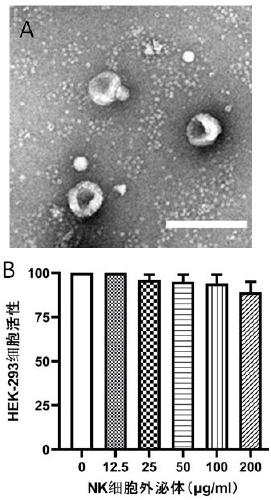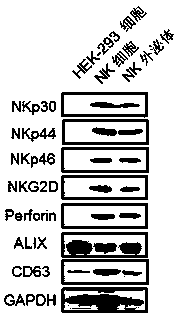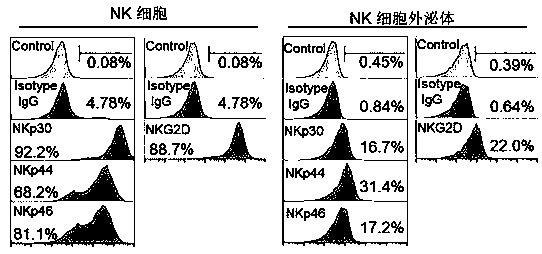Application of NK cell exosome and related miRNA in preparation of COVID-19 virus inhibitor
A COVID-19, virus inhibitor technology, applied in DNA/RNA fragments, antiviral agents, recombinant DNA technology, etc., can solve problems such as difficulty, high failure rate, long R&D cycle, etc., to achieve low cost and low side effects , fast effect
- Summary
- Abstract
- Description
- Claims
- Application Information
AI Technical Summary
Problems solved by technology
Method used
Image
Examples
Embodiment 1
[0022] Example 1: Acquisition of aNK exosomes and their structural characteristics
[0023] 1.1 Collect IL-21 culture medium for 18 days of NK cells to obtain activated NK cells aNK. Flow cytometry detects that the purity of aNK cells reaches more than 95%, and the culture medium is free of bacteria and mycoplasma contamination.
[0024] 1.2 The aNK cell culture solution was centrifuged at 400 g for 5 min in a bench-top low-speed centrifuge to remove the cell pellet, and the supernatant was collected and stored at 4°C for later use.
[0025] 1.3 Use the hollow fiber tangential filtration system (Spectrum Laboratories KrosFlo ResearchII TFF System) to purify the exosomes in the culture medium. First, a 0.45μm mPES hollow fiber filter column (P-S02-E45U-10-N) was used to remove cell debris in the cell culture fluid; the filtrate was further passed through an mPES hollow fiber filter column with a molecular weight cutoff of 300-kDa (S02- E300-05-N) was concentrated to obtain crude exos...
Embodiment 2
[0030] Example 2: aNK exosomal miRNA sequencing and analysis
[0031] According to the aNK exosomes obtained in Example 1, Nanjing Shihe Gene Biotechnology Co., Ltd. was entrusted to sequence the miRNA in the aNK exosomes. Use NEBNext Multiplex Small RNA Library Prep Set for Illumina (NEB, USA) to build the library, and add sequencing adapters to the samples to be sequenced. The samples were sequenced using the Illumina X-ten PE150 platform, with at least 300 M reads per sample. In order to reduce false positives, independent sequences with a signal-to-noise ratio greater than 100 are included in the calculation of miRDeep log-odds score, and the range of miRDeep log-odds score is set to -10~10. In order to discover new miRNAs in aNK exosomes, use miRDeep Score=0 is regarded as the cut-off value, and all miRNAs exceeding the cut-off value are regarded as brand new miRNAs. Sequencing results showed that there was a large amount of miRNA expression (43.92%) in aNK cell exosomes, ...
Embodiment 3
[0033] Example 3: Initial NK cells, aNK cells, aNK exosomes, miRNAs in aNK exosomes and miRNAs (M) after base replacement inhibit the expression of COVID-19 virus S (Spike) protein
[0034] The COVID-19 virus S protein exists on the surface of the virus and is the core protein for the COVID-19 virus to enter human cells. If the virus loses the S protein, it will no longer be able to further infect human cells, so the S protein is the target of a variety of inhibitor designs. In order to determine whether the exosomes secreted by the initial NK cells, aNK cells, and aNK cells have the ability to resist the COVID-19 virus, we first used the COVID-19 virus S protein overexpression system as a model to observe the initial NK cells, aNK cells, and aNK Exosomes inhibit the replication of virus S protein. We expressed the COVID-19 virus S protein particle on HEK-293 cells as the test object. The initial NK cells (1M / ml), the aNK cells (1M / ml) obtained by activation according to Exampl...
PUM
 Login to View More
Login to View More Abstract
Description
Claims
Application Information
 Login to View More
Login to View More - R&D
- Intellectual Property
- Life Sciences
- Materials
- Tech Scout
- Unparalleled Data Quality
- Higher Quality Content
- 60% Fewer Hallucinations
Browse by: Latest US Patents, China's latest patents, Technical Efficacy Thesaurus, Application Domain, Technology Topic, Popular Technical Reports.
© 2025 PatSnap. All rights reserved.Legal|Privacy policy|Modern Slavery Act Transparency Statement|Sitemap|About US| Contact US: help@patsnap.com



